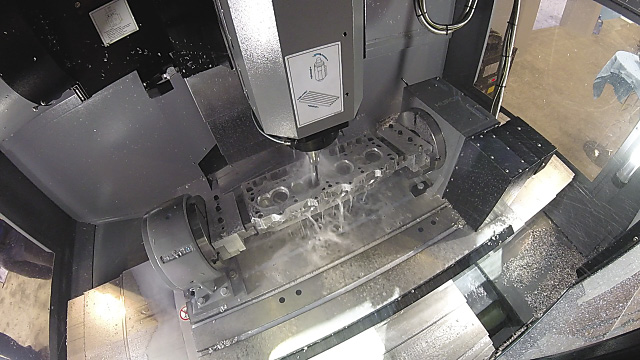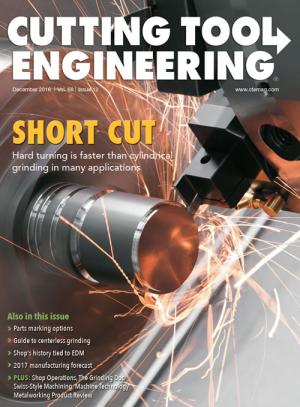
END USER: Mast Motorsports, (936) 560-2218, www.mastmotorsports.com.
SOLUTION PROVIDER: Hurco North America, (800) 634-2416, www.hurco.com.
CHALLENGE: Replace technologically obsolete production equipment.
SOLUTION: Purchase two new 5-axis CNC milling machines

Just because a piece of equipment functions doesn’t mean a shop should keep using it. Mast Motorsports realized that a couple machine tools at its Walled Lake, Mich., facility had become technologically obsolete and, therefore, needed to be replaced. The Nacogdoches, Texas-headquartered company manufactures automotive components, such as cylinder heads, intake manifolds and induction systems, for street performance and racing. Mast primarily machines aluminum and plastic.


A Mast Motorsports’ part is cut on a Hurco 5-axis CNC milling machine. Image by Dennis Spaeth. For a related video report, check out "Mast Motorsports makes Hurco pitstop."

After researching suitable replacement machines from Hurco North America at a trade show and considering similar offerings from other machine tool builders, Mast purchased two Hurco 5-axis CNC milling machines: a VMX60SRTi and a VMX42SWi. “The best replacement was the configuration Hurco had to offer,” said Cary Chouinard, director of manufacturing at Mast.
According to Indianapolis-based Hurco, the machines are configured to use a swivel head with either an A- or C-style rotary table. The rotary table measures 66"×26" (1,676.4mm × 660.4mm) and enhances versatility because it can provide extra table space for secondary operations or 3-axis work.
Chouinard also appreciates that the milling machines’ controls allow additional work to be performed at the machines. “The whole manual for operating the machine and everything that you want to know is right at the controller,” he said.
In addition, programming the machines isn’t a challenge. “Whether you’re using G and M codes or manually programming them, it’s very simple,” Chouinard said.
Compared to Mast’s outdated equipment, the Hurco machines are almost twice as fast, according to Chouinard. He added that Mast has been able to decrease machining time while reducing the step-over and producing more consistent and higher-quality parts. “The cost savings have been huge,” Chouinard said.
Although the quickness of the machines enables aggressive cutting, Chouinard noted the machines, which have a peak spindle motor horsepower of 48 hp (36.5kW) at 2,900 rpm, are quiet enough so that he can hear what is happening throughout the 7,500-sq.-ft. shop.
“It’s more advantageous for us to run with one line of machines,” Chouinard said, “so we’re trying to go with all Hurco equipment here.”
Related Glossary Terms
- computer numerical control ( CNC)
computer numerical control ( CNC)
Microprocessor-based controller dedicated to a machine tool that permits the creation or modification of parts. Programmed numerical control activates the machine’s servos and spindle drives and controls the various machining operations. See DNC, direct numerical control; NC, numerical control.
- gang cutting ( milling)
gang cutting ( milling)
Machining with several cutters mounted on a single arbor, generally for simultaneous cutting.
- milling
milling
Machining operation in which metal or other material is removed by applying power to a rotating cutter. In vertical milling, the cutting tool is mounted vertically on the spindle. In horizontal milling, the cutting tool is mounted horizontally, either directly on the spindle or on an arbor. Horizontal milling is further broken down into conventional milling, where the cutter rotates opposite the direction of feed, or “up” into the workpiece; and climb milling, where the cutter rotates in the direction of feed, or “down” into the workpiece. Milling operations include plane or surface milling, endmilling, facemilling, angle milling, form milling and profiling.
- milling machine ( mill)
milling machine ( mill)
Runs endmills and arbor-mounted milling cutters. Features include a head with a spindle that drives the cutters; a column, knee and table that provide motion in the three Cartesian axes; and a base that supports the components and houses the cutting-fluid pump and reservoir. The work is mounted on the table and fed into the rotating cutter or endmill to accomplish the milling steps; vertical milling machines also feed endmills into the work by means of a spindle-mounted quill. Models range from small manual machines to big bed-type and duplex mills. All take one of three basic forms: vertical, horizontal or convertible horizontal/vertical. Vertical machines may be knee-type (the table is mounted on a knee that can be elevated) or bed-type (the table is securely supported and only moves horizontally). In general, horizontal machines are bigger and more powerful, while vertical machines are lighter but more versatile and easier to set up and operate.
- step-over
step-over
Distance between the passes of the toolpath; the path spacing. The distance the tool will move horizontally when making the next pass. Too great of a step-over will cause difficulty machining because there will be too much pressure on the tool as it is trying to cut with too much of its surface area.


